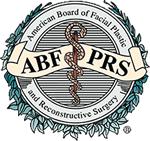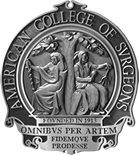Scar revision surgery can help reduce and diminish the appearance of scars that have formed due to trauma, surgery, injury, and more. While no scar can be removed completely, plastic surgery and scar revision surgery can often improve the appearance of a scar by making it less pronounced. Dr. Zimbler will examine the scar and discuss at length the treatment choices including the risks and benefits scar revision surgery. Whether it is revision surgery, steroid injections, laser treatments, many scars can be improved dramatically with minimal downtime. If you are bothered by a scar, your first step should be to consult with Dr. Zimbler regarding scar removal options.
Proper facial plastic surgery principles will minimize scarring; however, healing, genetics, and certain medical conditions can result in visible scarring. Certain steps can be taken to improve noticeable scars, some of which include silicone sheeting therapy, steroid injections, and Fraxel® laser treatments. However, when these techniques are not enough, surgical scar revision can help even out the appearance of a scar and reduce its visibility. Dr. Zimbler is an expert in scar revision surgery and uses the latest techniques to improve scars such as geometric broken line closures (GBLC), W-plasty, and Z-plasty. If you have a scar you are unhappy with and are considering scar revision surgery, a consultation with Dr. Zimbler will outline all of your available options. Dr. Zimbler can even customize scar reduction to best match your particular needs.
How do I know if scar revision surgery is right for me?
Scar revision can help reduce and diminish the appearance of a scar that you have as a result of a surgery, trauma, or an accident. If you are looking to reduce visible scars or to treat scars that hinder muscle activity, scar revision surgery may be right for you. Scar reduction can be tailored to best meet your particular goals. The type of scar revision treatment that is right for you depends on what type of scar you have. Scar revision surgery can help reduce the prominence of scars through procedures such as Z-plasty or skin grafts.
When is the best time to undergo scar revision?
Often, patients are told to wait at least 1 year following the formation of a scar before considering scar revision. Depending on the type of scar you have, early intervention can, in some cases, stop poor scar formation before it even occurs. Certain scars may improve dramatically with time, but other types of scars may never improve no matter how long you wait. While you give your scar time to heal, you can undergo other scar revision procedures such as silicone sheeting therapy, steroid injections, and laser treatments. The type of scar may dictate when intervention is best taken. Many scars that appear unattractive at first may become less visible over time. Dr. Zimbler will outline all of the available options and customize a scar reduction regimen that is best suited for you.
What is a hypertrophic scar?
A hypertrophic scar is often confused with a keloid scar. Both scars tend to be thick, raised, and red. Hypertrophic scars remain within the boundaries of the original scar and typically will improve with time. Treatment options include waiting, steroid injections, silicone sheeting, laser treatments, or scar revision surgery. Depending on the size and location of the scar, scar surgery may be performed in-office with local anesthesia or in the operating room under sedation anesthesia.
What is a keloid scar?
Keloids are thick, hard, raised scars that tend to itch and, in some cases, hurt. The skin color can be red or darkened causing the appearance of the scar to appear worse than it is. Keloid scars can develop soon after surgery or even months after the initial incident. Keloid scars can develop anywhere on the body but are more commonly found on the earlobes, shoulders, and chest. Commonly occurring in darker skinned patients, keloid scars will grow outside the boundaries of the original scar almost like a tumor.
Keloids are often treated with pressure, silicone sheeting, and steroid injections. More treatments include scar surgery and radiation therapy. Keloid scars are stubborn and can recur even larger than before. If you have a keloid scar and undergo treatment, your scar may require close observation for a period of time so that if the keloid scar does return, it is properly treated quickly.
| Hypertrophic Scars | Keloid Scars |
| Form from excess amounts of collagen | Are often thick and hard |
| Can Improve with time | Appear red or dark |
| Are often confused with keloid scars | Can develop anywhere on the body |
| Do not grow outside of the scar boundaries | Grow outside of the scar boundaries |
What is a Z-plasty?
A Z-plasty is a type of scar revision surgery in which the direction of a scar is changed in order to camouflage the scar or diminish a scar contracture. A scar contracture is a scar that is pulled in an unusual way causing an unnatural appearance to the scar. Contractures are often seen with burns or traumatic accidents but can be the result of poor wound healing after surgery. A Z-plasty gives the scar a Z-patterned appearance, which can diminish the appearance of a straight line scar. Other types of scar procedures that are used for scar camouflage include W-plasty, running W-plasty, multiple Z-plasties, or geometric broken line closure (GBLC).
What is a skin flap or graft?
In some cases, the entire scar needs to be surgically removed. By removing the scar, Dr. Zimbler then creates a new scar, which needs to be covered with healthy skin. This can be accomplished by stretching nearby normal skin, a method known as a skin flap, over the scar site. On the other hand, the scar can be covered with a skin graft from another location. Skin grafts are typically taken from more obscure locations so that the donor site scarring is minimalized. Areas such as behind the ear or under the arm are often used, as they are inconspicuous. Skin graft donor sites are chosen to best match the skin surrounding the scar. Skin grafts are determined based on size, color, and location of the scar.


















